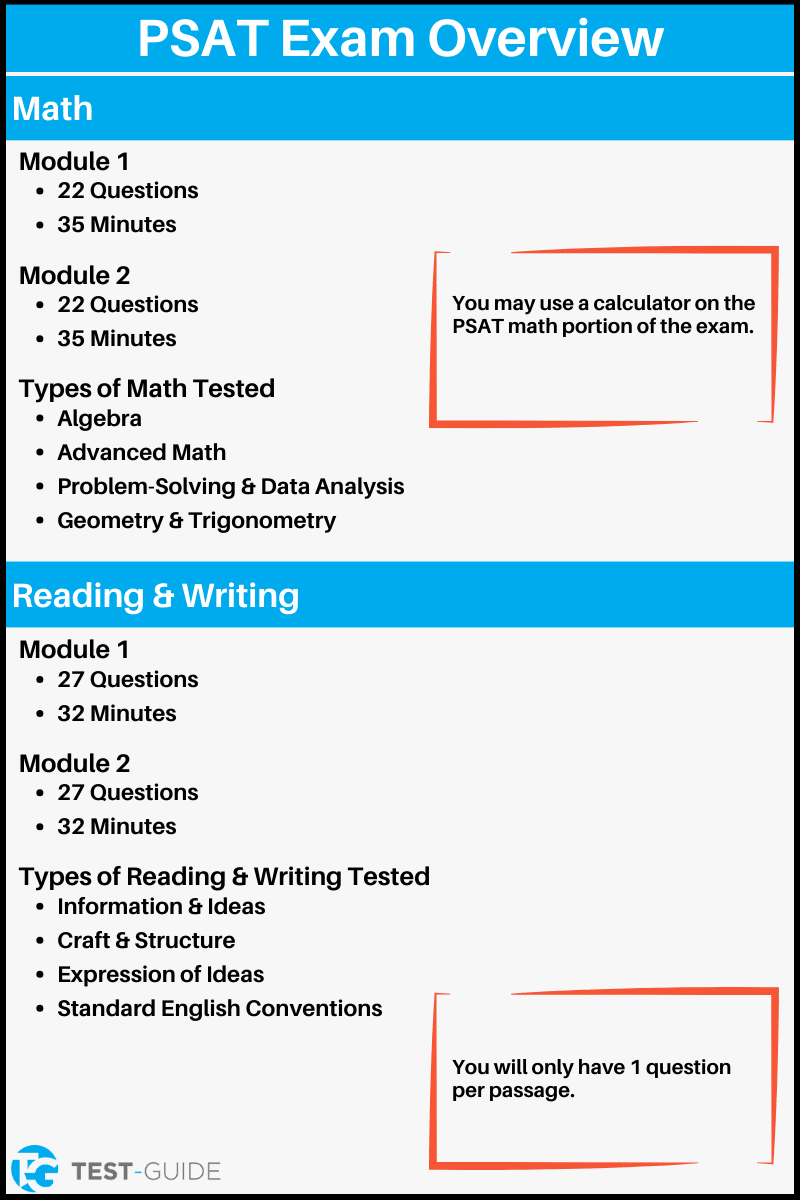All PSAT Practice Tests
If you want to use some more in-depth prep, use the resources listed below.
- Practice Exams = Timed and Full-Length
- Practice Sets = Not Timed and Smaller Sets of Questions
Official PSAT PDF Practice Exams
If you prefer to study with PDFs, use the links below. These are full-length practice exams provided by CollegeBoard.
| Test | Questions | Answers |
|---|---|---|
| Practice Test 1 (PDF) | Questions | Answers |
PSAT Exam Overview
The PSAT is an exam administered to high school students to help students prepare for the SAT and to qualify students for National Merit Scholarships.
The PSAT is created by the CollegeBoard and is administered by high schools throughout the United States to students in 10th or 11th grade.
The PSAT/NMSQT has switched to a fully digital format. The PSAT has undergone some formatting and content changes to switch to this new digital format. You can review those changes below.
The PSAT is made up of 2 sections, Math and Reading and Writing. Each of those sections is broken into 2 modules. Each module is timed and computer adaptive. This means that questions become easier or harder based on how you answer the previous question.
In total, there are 98 questions on the PSAT. You will have 134 minutes to take the PSAT.
| Section | Number of Questions | Length (Minutes) |
|---|---|---|
| Reading and Writing Module 1 | 27 | 32 |
| Reading and Writing Module 2 | 27 | 32 |
| Math Module 1 | 22 | 35 |
| Math Module 2 | 22 | 35 |
| Total | 98 | 134 |

You can learn more about the exam by reading our guide on what is the PSAT.
How to Use PSAT Practice Exams
When using our free PSAT practice tests, we recommend using these steps to get the most benefit from your practice:
- Take our first full-length practice exam from start to finish. Do not worry about preparing for it. This will be used as your baseline.
- Review your scores and see which sections gave you the most trouble.
- Focus on studying the section / subjects that gave you the most trouble. This will help you be more efficient by knowing what you need to study.
- Answer the PSAT practice questions in our practice sets above. Those questions are setup so that you can learn in an untimed environment and really focus on learning key concepts.
- Take another full-length practice exam and see where you stand.
- Repeat steps 2-4 as needed.
Benefits of PSAT Practice Questions
Using PSAT practice questions when preparing for the PSAT has many benefits. Some benefits include:
Narrow Down Problem Areas
You can narrow down which sections of the PSAT give you the most trouble by answering practice questions. After you narrow down those areas, you can study more efficiently and save yourself some time.
Timing
Timing is one of the more challenging aspects of the PSAT. You can prepare for this by taking our full-length PSAT practice tests above. You can find a pace that works for you and allows you to answer all of the questions in a timely manner.
Familiarity
The questions on the PSAT follow a certain format. By practicing questions beforehand, you will be exposed to the types of questions you will need to answer on the actual exam. This experience can be invaluable and help you earn a top score.
Problem-Solving
You can use our answer explanations to find new ways to solve the PSAT questions. There are multiple ways to solve these questions. We may present a new or different way to solve a problem that you thought of. This can help save you time or give you a different perspective.
Frequently Asked Questions
What is the PSAT scored out of?
The PSAT is scored on a scale from 320-1520. Each of the 2 sections is scored on a scale from 160-760. You can learn more about scores by reading our guide to PSAT scores.
When do you take the PSAT?
Students typically take the PSAT in 10th or 11th grade. The exam is administered by your high school.
Do colleges receive your PSAT score?
No, colleges will not receive your PSAT scores. They will not be used during the college admissions process.
What is the PSAT used for?
The PSAT is mainly used as preparation for the SAT. In addition, it is also used to qualify students for National Merit Scholarships.

